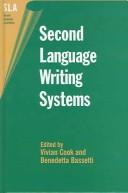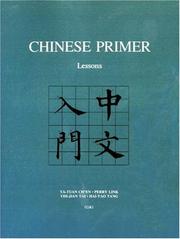| Listing 1 - 5 of 5 |
Sort by
|
Book
ISBN: 311060485X 9783110604856 9783110605181 311060518X 3110604760 Year: 2019 Publisher: Berlin/Boston De Gruyter
Abstract | Keywords | Export | Availability | Bookmark
 Loading...
Loading...Choose an application
- Reference Manager
- EndNote
- RefWorks (Direct export to RefWorks)
How are words written in German and English? What features do they share in common, and what are their differences? The book approaches these questions from a morphologic-graphemic perspective. Accordingly, it addresses the graphemic structure of morphemes, and the issues of uniformity (how uniformly is a morpheme represented in writing?) and uniqueness (how distinctly does a spelling refer to one morpheme?). Wie werden Wörter im Deutschen und im Englischen geschrieben? Wo sind Gemeinsamkeiten, wo sind Unterschiede? Diese Fragen werden aus morphologisch-graphematischer Perspektive bearbeitet. Es geht hier also nicht um Bezüge zwischen Schrift und Lautform (traditionell oft im Fokus der Graphematik), sondern um Korrespondenzen zwischen Schrift und Morphologie. Das betrifft zum einen den Aufbau von Morphemen. Welche Beschränkungen lassen sich hier für die Abfolge der Buchstaben formulieren? Was sind minimale, was sind prototypische Stämme und Affixe? Zum anderen geht es um Fragen der Einheitlichkeit (Wie uniform wird ein Morphem in der Schrift repräsentiert?) und der Eindeutigkeit (Wie distinkt verweist eine Schreibung auf ein Morphem?). Insgesamt zeigt sich, dass im Englischen eher Affixe verlässlich kodiert werden (oft eindeutig und einheitlich), während im Deutschen häufig Stämme einheitlich kodiert werden. Das sind zwei grundsätzlich unterschiedliche Strategien der Leseerleichterung.
Linguistics --- Grammar, syntax & morphology --- Writing systems, alphabets --- German language --- English language --- Morphology. --- Grapheme. --- morpheme. --- writing system. --- Germanic languages

ISBN: 1788920309 128082851X 9786610828517 1853597953 9781853597954 9781853597930 1853597937 9781853597947 1853597945 9781788920308 9781280828515 6610828512 Year: 2005 Publisher: Blue Ridge Summit, PA : Multilingual Matters,
Abstract | Keywords | Export | Availability | Bookmark
 Loading...
Loading...Choose an application
- Reference Manager
- EndNote
- RefWorks (Direct export to RefWorks)
Second Language Writing Systems looks at how people learn and use a second language writing system, arguing that they are affected by characteristics of the first and second writing systems, to a certain extent independently of the languages involved. This book presents for the first time the effects of writing systems on language reading and writing and on language awareness, and provides a new platform for discussing bilingualism, biliteracy and writing systems. The approach is interdisciplinary, with contributions not only from applied linguists and psychologists but also corpus linguists, educators and phoneticians. A variety of topics are covered, from handwriting to spelling, word recognition to the mental lexicon, and language textbooks to metalinguistic awareness. Though most of the studies concern adult L2 learners and users, other populations covered include minority children, immersion students and bilingual children. While the emphasis is on English as the L2 writing system, many other writing systems are analysed as L1 or L2: Arabic, Chinese, Dutch, Gujarati, Indonesian, Irish, Italian and Japanese. Approaches that are represented include contrastive analysis, transfer, poststructuralism, connectionism and corpus analysis. The readership is SLA and bilingualism researchers, students and teachers around the world; language teachers will also find much food for thought.
Language and languages - Orthography and spelling - Study and teaching. --- Second language acquisition. --- Language and languages --- Written communication --- Orthography and spelling --- Study and teaching. --- L2 Writing Systems. --- SLA. --- Second Language Acquisition. --- Second Language Writing System. --- bilingualism. --- biliteracy. --- mental lexicon. --- psycholinguistics. --- writing system.
Book
ISSN: 16333780 ISBN: 9782853997126 285399712X Year: 2008 Publisher: Aix-en-Provence : Publications de l'Université de Provence,
Abstract | Keywords | Export | Availability | Bookmark
 Loading...
Loading...Choose an application
- Reference Manager
- EndNote
- RefWorks (Direct export to RefWorks)
Written communication. --- Writing. --- Language and languages --- Dyslexia. --- Spelling disability. --- Communication écrite --- Ecriture --- Orthographe --- Dyslexie --- Dysorthographie --- Orthography and spelling. --- Written communication --- Writing --- Dyslexia --- Spelling disability --- Orthography and spelling --- Communication écrite --- French writing system --- Language and languages - Orthography and spelling
Book
ISBN: 0691230420 9780691230429 0691230420 Year: 2022 Publisher: Princeton ; Oxford : Princeton University Press,
Abstract | Keywords | Export | Availability | Bookmark
 Loading...
Loading...Choose an application
- Reference Manager
- EndNote
- RefWorks (Direct export to RefWorks)
"Reading literature in a time of climate emergency can sometimes feel a bit like fiddling while Rome burns. Yet, at this turning point for the planet, scientists, policymakers, and activists have woken up to the power of stories to fight global warming. In Literature for a Changing Planet, Martin Puchner ranges across four thousand years of world literature to draw vital lessons about how we put ourselves on the path of climate change-and how we might change paths before it's too late. From the Epic of Gilgamesh and the West African Epic of Sunjata to the Communist Manifesto, Puchner reveals world literature in a new light-as an archive of environmental exploitation and a product of a way of life responsible for climate change. Literature depends on millennia of intensive agriculture, urbanization, and resource extraction, from the clay of ancient tablets to the silicon of e-readers. Yet literature also offers powerful ways to change attitudes toward the environment. Puchner uncovers the ecological thinking behind the idea of world literature since the early nineteenth century, proposes a new way of reading in a warming world, shows how literature can help us recognize our shared humanity, and discusses the possible futures of storytelling. If we are to avoid environmental disaster, we must learn to tell the story of humans as a species responsible for global warming. Filled with important insights about the fundamental relationship between storytelling and the environment, Literature for a Changing Planet is a clarion call for readers and writers who care about the fate of life on the planet"--
Ecocriticism. --- Literature --- Ecological literary criticism --- Environmental literary criticism --- Criticism --- Appraisal of books --- Books --- Evaluation of literature --- Literary style --- History and criticism. --- Appraisal --- Evaluation --- Adventure Story (play). --- Aeneid. --- Age of Oil. --- Antihero. --- Aratta. --- Author. --- Book. --- Caesar and Pompey. --- City-state. --- Climate change. --- Colonial empire. --- Colonialism. --- Colonization. --- Comparative literature. --- Confucius. --- Conquistador. --- Critical reading. --- Deep history. --- Disaster. --- Divine retribution. --- Ecology. --- Economic globalization. --- Edition (book). --- Education. --- Enkidu. --- Enlil. --- Environmental economics. --- Epic of Gilgamesh. --- Epic poetry. --- Fan fiction. --- Flood myth. --- G. (novel). --- Genre. --- Global warming. --- Globalization. --- Hard Choices. --- Headline. --- Henry David Thoreau. --- Hippie. --- How It Happened. --- Humbaba. --- Immigration law. --- Industrialisation. --- Jataka tales. --- Johannes Gutenberg. --- Latin alphabet. --- Latin literature. --- Literary criticism. --- Literary realism. --- Literature. --- Manifesto. --- Mechanization. --- Narrative. --- New Narrative. --- New media. --- Novel. --- Novelist. --- Occupy Wall Street. --- Odysseus. --- Odyssey. --- Of Education. --- Orality. --- Poetry. --- Polyphemus. --- Popol Vuh. --- Preface. --- Publication. --- Publishing. --- Ralph Waldo Emerson. --- Refugee. --- Renaissance humanism. --- Right of asylum. --- Save the Planet. --- Scholarly method. --- Scrutiny (journal). --- Scrutiny. --- Settlement movement. --- Settler colonialism. --- Social movement. --- Sociocultural evolution. --- Storytelling. --- The Communist Manifesto. --- The Realist. --- The Various. --- Think tank. --- To This Day. --- Trickster. --- Unintended consequences. --- Uruk. --- Utnapishtim. --- Wai Chee Dimock. --- Western literature. --- William H. McNeill (historian). --- World economy. --- World history. --- World literature. --- Writer. --- Writing system. --- Writing.

ISBN: 0691036969 Year: 1994 Publisher: Princeton, N.J. : Princeton University Press,
Abstract | Keywords | Export | Availability | Bookmark
 Loading...
Loading...Choose an application
- Reference Manager
- EndNote
- RefWorks (Direct export to RefWorks)
Four experienced teachers of beginning Chinese have developed this introductory textbook. A pilot edition has been tested widely in classrooms and refined over a period of years. Among its salient features are lessons that are lively, amusing, and relevant to everyday life: concentrated training of ear and tongue in the sound system of Chinese; extensive grammar notes, clearly presented, with attention to mistakes English-speakers are likely to make; a carefully sequenced character workbook embodying a new and effective approach to the learning of Chinese characters; and audiovisual reinforcement via a complete set of audiotapes and two videotapes, one of which offers entertaining dramatizations of the lesson dialogues. The Chinese Primer is available in two versions, one using the GR system of romanization, which employs different spellings instead of diacritical marks for different tones, the other using Pinyin romanization. The contents of the four volumes are as follows: (1) Blue Book [Lessons]: Introduction; foundation work on pronunciation; lesson dialogues in romanized Chinese and English; appendices; glossary-index. (2) Red Book [Notes and Exercises]: Vocabularies; grammar notes and culture notes keyed to the lessons; exercises. (3) Yellow Book [Character Workbook]: workbook. (4) Green Book [Pinyin Character Text]: Texts of the lessons in both traditional and simplified Chinese characters, and a Chinese introduction for teachers. The first three volumes: Blue Book, Red Book, and Yellow Book are sold as a set GR Set or Pinyin Set). In addition, the GR Blue Book [Lessons], GR Red Book [Notes and Exercises], and GR Yellow Book [Character Workbook], along with the Pinyin Green Book [Pinyin Character Text] are sold separately. The GR Audio and video materials are available from the Chinese Linguistics Project at Princeton University for use with this text. These supplementary materials are not published by Princeton University Press. For further information and prices, contact the Chinese Linguistics Project, 231 Palmer Hall, Princeton University, Princeton, N.J. 08544. (609-258-4269).
Chinese language --- Textbooks for foreign speakers --- English. --- Adjective. --- Adverb. --- Alveolar and postalveolar approximants. --- Amoy dialect. --- Ancient China. --- Basic English. --- Beijing dialect. --- Beijing. --- Calligraphy. --- China proper. --- China. --- Chinese calligraphy. --- Chinese characters. --- Chinese culture. --- Chinese grammar. --- Chinese language. --- Chinese literature. --- Chinese name. --- Chinese painting. --- Chinese people. --- Chinese surname. --- Chinese tea. --- Classical Chinese. --- Classical language. --- Consonant cluster. --- Consonant. --- Contraction (grammar). --- Cursive. --- Determinative. --- Dialect continuum. --- Dialect. --- English phonology. --- Fill-In (puzzle). --- Fuzhou dialect. --- Grammar. --- Guangxi. --- Guangzhou. --- Gwoyeu Romatzyh. --- Han Chinese. --- Handwriting. --- Hebei. --- Heilongjiang. --- Hubei. --- Ideograph (rhetoric). --- Intonation (linguistics). --- Japanese books. --- Jargon. --- Jia (vessel). --- Jian. --- Jiangxi. --- Lingua franca. --- Loanword. --- Mainland China. --- Mandarin Chinese. --- May Fourth Movement. --- Mencius. --- Newspaper. --- No Chinese. --- North American English regional phonology. --- Numeral (linguistics). --- Old Chinese. --- Overseas Chinese. --- Phoneme. --- Phonemic orthography. --- Phrase. --- Physiognomy. --- Pinyin. --- Pronunciation. --- Rhoticity in English. --- Romanization of Chinese. --- Romanization. --- Shanghainese. --- Shin (letter). --- Sichuan. --- Simplified Chinese characters. --- Spelling rule. --- Standard Chinese. --- Surname. --- Syllable. --- Textbook. --- The Chinese Way. --- Tian. --- Tone (linguistics). --- Traditional Chinese characters. --- Transliteration. --- Usage. --- Variant form (Unicode). --- Varieties of Chinese. --- Verb. --- Vocabulary. --- Vowel. --- Wade–Giles. --- Workbook. --- Writing system. --- Writing. --- Written Chinese. --- Wu Chinese. --- Yunnan. --- Zhejiang. --- Zhou Enlai.
| Listing 1 - 5 of 5 |
Sort by
|

 Search
Search Feedback
Feedback About
About Help
Help News
News